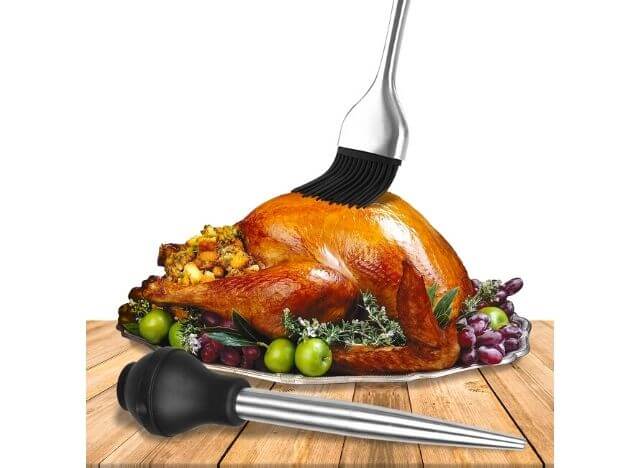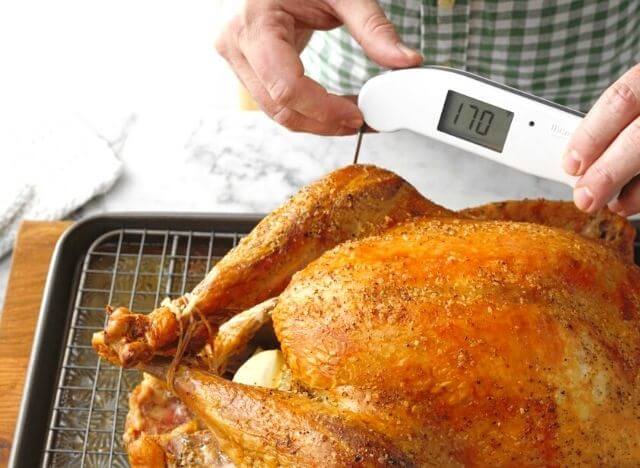Are you facing a last-minute Thanksgiving turkey dilemma? Don’t fret! In this article, I will unveil the secrets of how to cook a frozen turkey for Thanksgiving, ensuring a delicious and stress-free holiday feast.
Say goodbye to the thawing waiting game and hello to a mouthwatering, perfectly cooked turkey that will impress your guests. Let’s dive into the step-by-step process of cooking a frozen turkey that will become a new Thanksgiving tradition!
Cooking Time For Frozen Turkey
First, it is crucial to determine the estimated cooking time for your unthawed bird. We will use a 12-pound turkey as our reference point for the instructions below.

If your turkey is larger, you should anticipate an increase of approximately 50% in the regular roasting duration. And if you wonder how long to cook a partially frozen turkey, you can estimate that it will take roughly 25% longer to cook than a fully frozen one.
Here are the recommended cooking times according to expert advice:
- 8 to 12-pound turkey: Approximately 4 to 4.5 hours
- 12 to 14-pound turkey: About 4.5 to 5.75 hours
- 14 to 18-pound turkey: Around 6 to 6.75 hours
- 18 to 20-pound turkey: Roughly 6.75 to 7.5 hours
- 20 to 24-pound turkey: Approximately 7.5 to 7.75 hours
How To Cook A Frozen Turkey For Thanksgiving
Step 1: Thaw it in an oven
Set your appliance to 325 degrees F. Afterward, unwrap the frozen turkey and position it on a rack inside a shallow roasting pan. There is no need to concern yourself with removing the giblets at this point; we will address that later in the process.
If you don’t have a dedicated rack, consider using a substitute like a cooling rack to elevate the turkey, allowing hot air to circulate freely around it. Rest assured, whether you are working with a frozen or thawed bird, flavor is not compromised in either case.
Waiting for about 2 hours and resisting any temptation to peek during this time is crucial!
Tips: For easier cleanup down the road, consider lining the pan with either a baking mat (like Silpat) or foil.
Step 2: Add flavor and continue cooking
After the initial two hours, the legs and thighs should have significantly thawed and reached a temperature of around 100°F. The breast will typically be thawed to a depth of approximately an inch but will remain frozen beyond that point.

If desired, you can opt to brush the bird’s exterior with oil or butter and season it with pepper, dried herbs, and salt at this stage. Return the turkey to the oven and continue roasting at 325°F for an additional 30 minutes, adjusting the time accordingly if you are working with a larger bird.
Step 3: Remove the giblets
Frequently, turkey packaging includes the giblet bag in its neck area rather than the cavity. At this stage, the neck area of the bird should have thawed sufficiently to allow for the removal of the giblet bag.
However, the cavity may still be partially frozen, so it is important not to attempt to remove a bag from it just yet.
If the giblet bag is made of plastic, removing it well before any chance of melting is crucial. Any plastic melting can release harmful chemicals into the meat, so exercise caution in this regard.
Step 4: Check the temperature
Allow the turkey to continue cooking for an additional 1 hour. The legs and thighs should reach temperatures of approximately 130 to 150°F, while the breast will be 50 to 60°F.
For the most accurate temperature assessment, it is recommended to use a cooking thermometer. Insert the thermometer’s probe into the thickest part of the meat. This method ensures precise monitoring of the turkey’s internal temperature for perfectly cooked results.
Before returning it to the oven for the final stretch, you can brush the bird with additional oil. Roast for another 1 or 1.5 hours, ensuring that the dish reaches the desired internal temperature for safe and delicious cooking.

Step 5: Finish cooking and leave it at room temperature
The turkey should be done around 4.5 to 5 hours after the cooking process begins. The breast’s internal temperature should reach 165°F while its thighs and legs should register between 170 to 175°F. Once these temperature milestones are gone, it’s time to remove the turkey from your appliance.
Let the turkey rest for 30 minutes before carving is highly recommended. Rest assured, it will still be piping hot when it reaches the table. Allowing this resting period results in juicier and more effortlessly carved slices.
An important tip: Avoid covering the turkey with foil during this time, as it can trap steam and compromise the crispness of the skin.
If you are seeking instructions on how to cook a partially frozen turkey, you can use the same guide provided above with the understanding that it will require a shorter cooking time.
What do you need to cook a frozen turkey?
Cooking a frozen turkey isn’t as difficult as you might imagine. There are very few kitchen gadgets involved. A simple list of devices is all you need.
- Roasting pan
- Kitchen timer
- Cooking Thermometer
- Basting brush or baster
There are many different techniques for basting. You need to prepare the flavor from butter, herbs and spices.
How To Safety Thaw A Frozen Turkey?
While cooking a frozen turkey can be convenient, some prefer the traditional approach of defrosting before roasting for the best results.
If you have the time to spare, understanding how to thaw a frozen turkey is a valuable skill to ensure a delicious and safe meal.
Thaw in the fridge
- Do not unwrap, but keep the bird in its original packaging in the cooling compartment for a few days.
- Set the turkey on a dish or a tray to capture potential drips or leaks.
So, how long will a thawed turkey keep in the fridge? A properly thawed one can be safely stored in the fridge for up to 2 days.
Thaw using cold water
- Securely wrap the bird, ensuring no water can penetrate its packaging.
- Immerse the wrapped turkey in cold water.
- Replace the water every 1/2 hour to maintain a safe and consistent temperature.
- As soon as the turkey is fully thawed, cook it immediately.
- Avoid refreezing once it has been defrosted using this method.
Things you should avoid
- Let the thawed bird out at room temperature for a few hours.
- Immersing it in hot water.
- Using a heating pad as a wrapping method.
- Attempting to hasten the process with a hair dryer.
- Other shortcuts in the thawing process.
The risk of potential food poisoning for you and your guests is too high to take these practices!
How To Store Leftover Turkey?
For the safe storage of leftovers, it is crucial to act promptly. Within a two-hour cooking, break down your leftover dishes into smaller portions and store them in shallow, covered containers. Avoid cooling down large containers or entire turkeys slowly, as this can provide an opportunity for bacteria to multiply.
According to a recent USDA research, 76% of respondents said they refrigerated leftovers only after leaving them at room temperature. However, this practice is unnecessary and can jeopardize your food’s safety. It is essential to promptly place leftovers in the refrigerator or freezer, even if they emit steam or heat.
As some might wonder how to tell if frozen turkey is bad, if your bird exhibits signs of being discolored, slimy, or emits an unusual odor, it is imperative to discard it.
FAQs
Why Turkey On Thanksgiving Dinner?
Rather than some historical connections, this tradition has other key reasons. Firstly, a roasted turkey is an ideal centerpiece for a festive celebration.
Additionally, this animal is a practical choice when feeding a large group of people. They are larger than many other birds, and they offer a cost-effective alternative to beef or pork.
Is It Safe To Cook A Frozen Turkey?
Now that you have learned how to cook a frozen turkey in the oven, you have likely realized that cooking a fully frozen bird is indeed safe. The process poses no harm and can be a convenient way to prepare your holiday meal.
According to the USDA, in the danger zone (between 40°F and 140°F), harmful bacteria and toxins can build up to harmful levels. Therefore, when defrosting and cooking a turkey, our goal is to get it past the danger zone as quickly as possible.
Can You Cook A Frozen Turkey Without Thawing?
Yes, it is possible to cook a frozen turkey without thawing it. Doing this way, it will still result in a moist and delicious turkey.
How Long Can Thawed Ground Turkey Stay In The Fridge?
Detecting the freshness of ground poultry can be particularly challenging by sight alone. It may spoil before showing any visual signs, underscoring the importance of consuming it promptly.
Typically, thawed ground turkey and chicken remain safe for consumption for just two or three days when stored in the refrigerator.
How Long Does Sliced Turkey Last In The Fridge?
You can keep them in the fridge for 3 to 4 days after their preparation. Sliced deli turkey, especially if vacuum-sealed, might last a bit longer, but once you have opened the package, it is best to enjoy it within a week to maintain its taste and safety.
Final Thoughts
In conclusion, knowing how to cook a frozen turkey for Thanksgiving is a game-changer. You can confidently prepare a superb holiday centerpiece no longer bound by thawing schedules.
Remember, your allies are your patience, accurate cooking times, and a trusty meat thermometer. Embrace the convenience and savor the delicious results. So, when the frozen turkey dilemma arises next Thanksgiving, fear not – you’ve got the skills to create a memorable, stress-free feast. Happy cooking and happy Thanksgiving!

